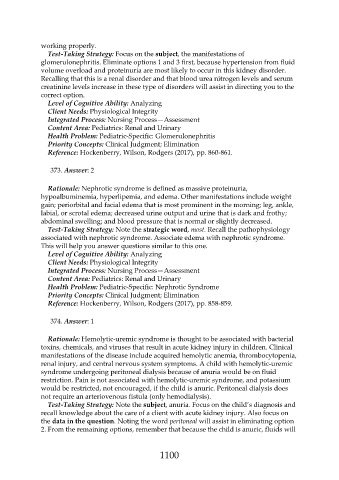Page 1100 - Saunders Comprehensive Review For NCLEX-RN
P. 1100
working properly.
Test-Taking Strategy: Focus on the subject, the manifestations of
glomerulonephritis. Eliminate options 1 and 3 first, because hypertension from fluid
volume overload and proteinuria are most likely to occur in this kidney disorder.
Recalling that this is a renal disorder and that blood urea nitrogen levels and serum
creatinine levels increase in these type of disorders will assist in directing you to the
correct option.
Level of Cognitive Ability: Analyzing
Client Needs: Physiological Integrity
Integrated Process: Nursing Process—Assessment
Content Area: Pediatrics: Renal and Urinary
Health Problem: Pediatric-Specific: Glomerulonephritis
Priority Concepts: Clinical Judgment; Elimination
Reference: Hockenberry, Wilson, Rodgers (2017), pp. 860-861.
373. Answer: 2
Rationale: Nephrotic syndrome is defined as massive proteinuria,
hypoalbuminemia, hyperlipemia, and edema. Other manifestations include weight
gain; periorbital and facial edema that is most prominent in the morning; leg, ankle,
labial, or scrotal edema; decreased urine output and urine that is dark and frothy;
abdominal swelling; and blood pressure that is normal or slightly decreased.
Test-Taking Strategy: Note the strategic word, most. Recall the pathophysiology
associated with nephrotic syndrome. Associate edema with nephrotic syndrome.
This will help you answer questions similar to this one.
Level of Cognitive Ability: Analyzing
Client Needs: Physiological Integrity
Integrated Process: Nursing Process—Assessment
Content Area: Pediatrics: Renal and Urinary
Health Problem: Pediatric-Specific: Nephrotic Syndrome
Priority Concepts: Clinical Judgment; Elimination
Reference: Hockenberry, Wilson, Rodgers (2017), pp. 858-859.
374. Answer: 1
Rationale: Hemolytic-uremic syndrome is thought to be associated with bacterial
toxins, chemicals, and viruses that result in acute kidney injury in children. Clinical
manifestations of the disease include acquired hemolytic anemia, thrombocytopenia,
renal injury, and central nervous system symptoms. A child with hemolytic-uremic
syndrome undergoing peritoneal dialysis because of anuria would be on fluid
restriction. Pain is not associated with hemolytic-uremic syndrome, and potassium
would be restricted, not encouraged, if the child is anuric. Peritoneal dialysis does
not require an arteriovenous fistula (only hemodialysis).
Test-Taking Strategy: Note the subject, anuria. Focus on the child’s diagnosis and
recall knowledge about the care of a client with acute kidney injury. Also focus on
the data in the question. Noting the word peritoneal will assist in eliminating option
2. From the remaining options, remember that because the child is anuric, fluids will
1100

